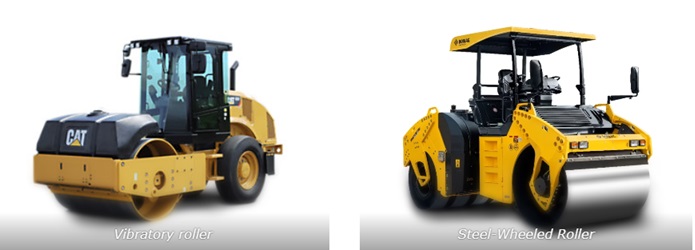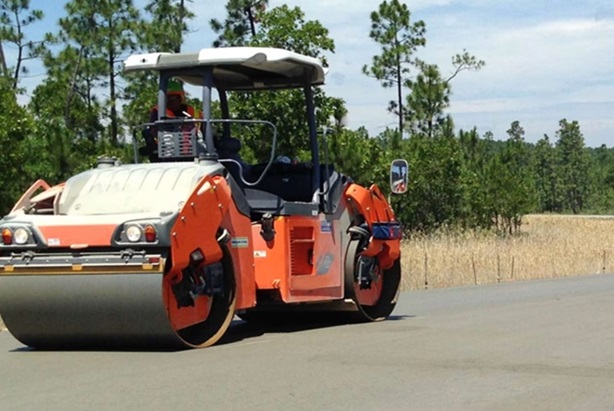Roller Compacted Concrete (RCC) enhances pavement durability by using a dry or low-slump concrete mix of cement, aggregates, and water, which is then compacted with rollers. Unlike conventional concrete, RCC requires no forms, dowels, or reinforcing steel, and its construction involves a faster and cost-effective process. The compacted layers form a dense, strong pavement capable of withstanding heavy loads and harsh conditions, making it ideal for infrastructure projects.
Roller Compacted Concrete (RCC) Pavement Applications
Roller Compacted Concrete (RCC) pavements are widely used in various applications that include:
- Industrial sites
- Truck terminals and ports
- Parking lots
- Roadways
- Airports
- Paved trails and pathways
- Temporary road surfaces
- Mining
- Dam and reservoir spillways
- Paved trails and pathways
- Temporary road surfaces
Advantages of Roller Compacted Concrete (RCC):
- Resistant to wear, cracking, and damage from heavy traffic.
- Simpler and more economical construction compared to traditional materials.
- Less frequent repairs needed due to its strength and longevity.
- Faster placement and compaction, reducing overall project time.
- Longer lifespan and fewer repairs lead to reduced environmental impact.
- Withstands heavy truck and industrial traffic loads without significant wear.
- Helps minimize surface cracking by distributing loads evenly.
- Performs well in both hot and cold climates without significant degradation.
- Saves labour costs by eliminating extensive finishing processes.
- Provides enhanced skid resistance, reducing accident risks in wet conditions.
- Can be recycled and reused in future construction projects.
Types of Rollers Used for Roller Compacted Concrete (RCC) Pavements

- Vibratory Rollers- Vibratory rollers are equipped with vibrating drums that combine static weight and vibratory force to compact the RCC mix effectively. The vibrations cause the particles to settle tightly, reducing voids and ensuring a well-consolidated surface. These rollers are particularly advantageous for compacting thick RCC layers and achieving high-density pavements. Their features include adjustable frequency and amplitude settings, which allow operators to customize the compaction intensity based on the mix design and layer thickness. Vibratory rollers ensure faster compaction and are highly efficient for large-scale projects where uniform density is important.
- Steel-Wheeled Rollers– Steel-wheeled rollers use heavy steel drums to apply consistent pressure, providing excellent compaction for a dense and smooth surface. These rollers are ideal for the final finishing of RCC pavements as they deliver a polished surface that can withstand heavy traffic loads. Key features include their high weight and robust design, which enable them to compact even the most rigid mixes effectively. Steel-wheeled rollers are particularly advantageous in creating a uniform, load-bearing surface, ensuring the pavement’s long-term durability and strength.
- Pneumatic-Tyred Rollers- Pneumatic-tyred rollers feature multiple rubber tires that distribute pressure evenly across the pavement. These rollers provide a kneading action that compacts the RCC mix while improving surface texture and uniformity. Their flexibility allows them to adapt to minor surface irregularities, making them effective for edge compaction and areas requiring a smooth finish. Advantages of pneumatic-tired rollers include their ability to reduce air voids and improve the bond between layers, enhancing the overall strength and quality of the pavement. Their design also minimizes surface cracking, contributing to the pavement’s durability.
- Static Rollers– Static rollers rely solely on their weight for compaction, without using vibration. They are ideal for initial compaction phases or areas sensitive to vibrations, such as near existing structures, underground utilities, or fragile surroundings. Static rollers are characterized by their simplicity and stability, offering controlled and uniform compaction. Their advantage lies in their ability to provide a stable base for subsequent layers without causing disruptions. Though less aggressive than vibratory rollers, they are an essential tool for creating a well-prepared base for RCC pavements.
- Dual-Direction Rollers- Dual-direction rollers are designed to compact in both forward and reverse directions, enhancing operational efficiency. These rollers are particularly beneficial for large-scale projects where time and consistency are essential. Key features include easy directional control, high maneuverability, and the ability to maintain uniform compaction in confined spaces. The dual-direction functionality reduces the time needed to cover an area while ensuring the same level of compaction throughout. These rollers are advantageous in improving the speed of construction without compromising the pavement’s strength or quality.
How to Select the Right Roller for RCC Pavements?
- Assess compaction needs based on pavement thickness and load requirements.
- Select rollers that achieve the desired surface finish, such as smooth or textured.
- Opt for efficient rollers for large-scale projects to save time.
- Consider site conditions like terrain and proximity to sensitive areas.
- Match roller type to the RCC layer thickness for consistent compaction.
- Ensure rollers align with project timelines and enhance productivity.
- Choose rollers compatible with the RCC mix’s aggregate size and moisture content.
- Use compact rollers for confined or hard-to-reach spaces.
- Prioritize rollers with minimal vibrations for sensitive environments.
Other Equipments used for Roller Compacted Concrete (RCC) Pavements
In addition to rollers, several other types of equipment are used in the construction of Roller Compacted Concrete (RCC) pavements to ensure proper mixing, spreading, compaction, and finishing. Some of these key equipments include:
- Motor Graders: Motor graders are used to spread and level the RCC mix across the site to the desired thickness. They help in creating a smooth and uniform base before compaction.
- Pavers: Paving machines or pavers are used for the accurate and efficient placement of the RCC mixture, particularly for large-scale projects. They ensure a consistent layer of material across the pavement.
- Skid Steer Loaders and Front-End Loaders: These are used to move and distribute the material across the site. They are particularly useful for smaller or more detailed work areas.
- Vibratory Plate Compactors: These compact the RCC in smaller areas or hard-to-reach places where large rollers cannot operate.
- Trucks with Water Tankers: Water trucks may be used for moistening the RCC mix to aid in the compaction process, especially in hot climates where the material may dry out too quickly.
Conclusion
Roller Compacted Concrete (RCC) pavements deliver durable, cost-effective surfaces for various infrastructure projects. By utilizing the right compaction equipment, they ensure strong, long-lasting performance with minimal maintenance requirements. This makes RCC an ideal solution for a wide range of applications, from roads and parking lots to industrial sites and ports, providing reliable surfaces that can withstand heavy traffic and harsh conditions.


